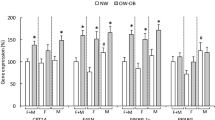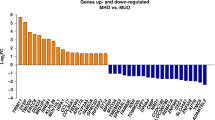Abstract
Background:
Peripheral blood mononuclear cells (PBMC) can be collected easily and repeatedly. Their potential use to reflect the individual's biological status is increasingly explored. Obesity is becoming the most common health problem of the 21st century, being dietary intake an important determinant of this pathology and numerous chronic health conditions.
Objective:
The aim of this study is to identify PBMC genes involved in energy homeostasis, which could be good markers of overweight development.
Design:
Using whole-genome microarray analysis, we evaluated the gene expression in PBMC of normoweight and diet-induced obese (cafeteria-fed) Wistar rats.
Results:
Microarray analysis showed 566 genes differentially expressed between normoweight and cafeteria-fed rats. Of these, 35 genes were particularly involved in energy homeostasis. The gene with the biggest fold change was the ‘solute carrier family 27 (fatty acid transporter), member 2’ (slc27a2), which is implicated in lipid biosynthesis and fatty acid degradation. Scl27a2 was 33-fold overexpressed in cafeteria-fed rats compared with normoweight rats. This result was confirmed by quantitative PCR, although the overexpression was smaller (sixfold). Moreover, the increase in slc27a2 expression in PBMC of cafeteria-fed rats from 2 to 6 months of age paralleled the increase in body weight.
Conclusion:
The progressive overexpression of slc27a2 in PBMC of cafeteria-fed rats as the body weight increases suggests this gene as an early marker of overweight development related to the intake of a hyperlipidic diet.
This is a preview of subscription content, access via your institution
Access options
Subscribe to this journal
Receive 12 print issues and online access
$259.00 per year
only $21.58 per issue
Buy this article
- Purchase on Springer Link
- Instant access to full article PDF
Prices may be subject to local taxes which are calculated during checkout


Similar content being viewed by others
Accession codes
References
Palou A, Serra F, Bonet ML, Pico C . Obesity: molecular bases of a multifactorial problem. Eur J Nutr 2000; 39: 127–144.
Ginter E, Simko V . Adult obesity at the beginning of the 21st century: epidemiology, pathophysiology and health risk. Bratisl Lek Listy 2008; 109: 224–230.
Ayala GX, Baquero B, Klinger S . A systematic review of the relationship between acculturation and diet among Latinos in the United States: implications for future research. J Am Diet Assoc 2008; 108: 1330–1344.
Weisburger JH . Dietary fat and risk of chronic disease: mechanistic insights from experimental studies. J Am Diet Assoc 1997; 97: S16–S23.
Von Diemen V, Trindade EN, Trindade MR . Experimental model to induce obesity in rats. Acta Cir Bras 2006; 21: 425–429.
Berraondo B, Marti A, Duncan JS, Trayhurn P, Martinez JA . Up-regulation of muscle UCP2 gene expression by a new beta3-adrenoceptor agonist, trecadrine, in obese (cafeteria) rodents, but down-regulation in lean animals. Int J Obes Relat Metab Disord 2000; 24: 156–163.
Berraondo B, Martinez JA . Free fatty acids are involved in the inverse relationship between hormone-sensitive lipase (HSL) activity and expression in adipose tissue after high-fat feeding or beta3-adrenergic stimulation. Obes Res 2000; 8: 255–261.
Lopez IP, Marti A, Milagro FI, Zulet Md Mde L, Moreno-Aliaga MJ, Martinez JA et al. DNA microarray analysis of genes differentially expressed in diet-induced (cafeteria) obese rats. Obes Res 2003; 11: 188–194.
Rodriguez AM, Palou A . Uncoupling proteins: gender dependence and their relation to body weight control. Int J Obes Relat Metab Disord 2004; 28: 500–502.
Ribot J, Rodriguez AM, Rodriguez E, Palou A . Adiponectin and resistin response in the onset of obesity in male and female rats. Obesity (Silver Spring) 2008; 16: 723–730.
Mercader J, Granados N, Caimari A, Oliver P, Bonet ML, Palou A . Retinol-binding protein 4 and nicotinamide phosphoribosyltransferase/visfatin in rat obesity models. Horm Metab Res 2008; 40: 467–472.
Rodricks JV . Approaches to risk assessment for macronutrients and amino acids. J Nutr 2003; 133: 2025S–2030S.
Renwick AG . The safety testing of amino acids. J Nutr 2003; 133: 2031S–2033S.
Bier DM . Amino acid pharmacokinetics and safety assessment. J Nutr 2003; 133: 2034S–2039S.
de Mello VD, Kolehmainen M, Schwab U, Mager U, Laaksonen DE, Pulkkinen L et al. Effect of weight loss on cytokine messenger RNA expression in peripheral blood mononuclear cells of obese subjects with the metabolic syndrome. Metabolism 2008; 57: 192–199.
Maas K, Chan S, Parker J, Slater A, Moore J, Olsen N et al. Cutting edge: molecular portrait of human autoimmune disease. J Immunol 2002; 169: 5–9.
Burczynski ME, Dorner AJ . Transcriptional profiling of peripheral blood cells in clinical pharmacogenomic studies. Pharmacogenomics 2006; 7: 187–202.
Ghanim H, Aljada A, Hofmeyer D, Syed T, Mohanty P, Dandona P . Circulating mononuclear cells in the obese are in a proinflammatory state. Circulation 2004; 110: 1564–1571.
O’Rourke RW, Kay T, Lyle EA, Traxler SA, Deveney CW, Jobe BA et al. Alterations in peripheral blood lymphocyte cytokine expression in obesity. Clin Exp Immunol 2006; 146: 39–46.
Samara A, Marie B, Pfister M, Visvikis-Siest S . Leptin expression in peripheral blood mononuclear cells (PBMCs) is related with blood pressure variability. Clin Chim Acta 2008; 395: 47–50.
Tsiotra PC, Tsigos C, Yfanti E, Anastasiou E, Vikentiou M, Psarra K et al. Visfatin, TNF-alpha and IL-6 mRNA expression is increased in mononuclear cells from type 2 diabetic women. Horm Metab Res 2007; 39: 758–763.
Patel L, Buckels AC, Kinghorn IJ, Murdock PR, Holbrook JD, Plumpton C et al. Resistin is expressed in human macrophages and directly regulated by PPAR gamma activators. Biochem Biophys Res Commun 2003; 300: 472–476.
Pagmantidis V, Meplan C, van Schothorst EM, Keijer J, Hesketh JE . Supplementation of healthy volunteers with nutritionally relevant amounts of selenium increases the expression of lymphocyte protein biosynthesis genes. Am J Clin Nutr 2008; 87: 181–189.
Caimari A, Oliver P, Keijer J, Palou A . Peripheral blood mononuclear cells as a model to study the response of energy homeostasis-related genes to acute changes in feeding conditions. OMICS 2009 (in press).
Nadler ST, Stoehr JP, Schueler KL, Tanimoto G, Yandell BS, Attie AD . The expression of adipogenic genes is decreased in obesity and diabetes mellitus. Proc Natl Acad Sci USA 2000; 97: 11371–11376.
Soukas A, Cohen P, Socci ND, Friedman JM . Leptin-specific patterns of gene expression in white adipose tissue. Genes Dev 2000; 14: 963–980.
Soukas A, Socci ND, Saatkamp BD, Novelli S, Friedman JM . Distinct transcriptional profiles of adipogenesis in vivo and in vitro. J Biol Chem 2001; 276: 34167–34174.
Allison DB, Cui X, Page GP, Sabripour M . Microarray data analysis: from disarray to consolidation and consensus. Nat Rev Genet 2006; 7: 55–65.
Pellis L, Franssen-van Hal NL, Burema J, Keijer J . The intraclass correlation coefficient applied for evaluation of data correction, labeling methods, and rectal biopsy sampling in DNA microarray experiments. Physiol Genomics 2003; 16: 99–106.
NCBI GEO. http://www.ncbi.nlm.nih.gov/geo/.
Lee HK, Braynen W, Keshav K, Pavlidis P . ErmineJ: tool for functional analysis of gene expression data sets. BMC Bioinformatics 2005; 6: 269.
Livak KJ, Schmittgen TD . Analysis of relative gene expression data using real-time quantitative PCR and the 2(-Delta Delta C(T)) Method. Methods 2001; 25: 402–408.
Matthews DR, Hosker JP, Rudenski AS, Naylor BA, Treacher DF, Turner RC . Homeostasis model assessment: insulin resistance and beta-cell function from fasting plasma glucose and insulin concentrations in man. Diabetologia 1985; 28: 412–419.
Smas CM, Sul HS . Control of adipocyte differentiation. Biochem J 1995; 309 (Pt 3): 697–710.
Spiegelman BM, Flier JS . Adipogenesis and obesity: rounding out the big picture. Cell 1996; 87: 377–389.
Campion J, Milagro FI, Fernandez D, Martinez JA . Differential gene expression and adiposity reduction induced by ascorbic acid supplementation in a cafeteria model of obesity. J Physiol Biochem 2006; 62: 71–80.
Uchiyama A, Aoyama T, Kamijo K, Uchida Y, Kondo N, Orii T et al. Molecular cloning of cDNA encoding rat very long-chain acyl-CoA synthetase. J Biol Chem 1996; 271: 30360–30365.
Hirsch D, Stahl A, Lodish HF . A family of fatty acid transporters conserved from mycobacterium to man. Proc Natl Acad Sci USA 1998; 95: 8625–8629.
Steinberg SJ, Wang SJ, Kim DG, Mihalik SJ, Watkins PA . Human very-long-chain acyl-CoA synthetase: cloning, topography, and relevance to branched-chain fatty acid metabolism. Biochem Biophys Res Commun 1999; 257: 615–621.
Steinberg SJ, Wang SJ, McGuinness MC, Watkins PA . Human liver-specific very-long-chain acyl-coenzyme A synthetase: cDNA cloning and characterization of a second enzymatically active protein. Mol Genet Metab 1999; 68: 32–42.
Acknowledgements
CIBER de Fisiopatología de la Obesidad y Nutrición is an initiative of the ISCIII. This work was supported by the Spanish Government (Ministerio de Educación y Ciencia, AGL2006-04887/ALI and AGL2009–11277/ALI). The groups of AP and JK are members of the European Research Network of Excellence NuGO (the European Nutrigenomics Organization, EU Contract: FOOD-CT-2004-506360 NUGO).
Author information
Authors and Affiliations
Corresponding author
Ethics declarations
Competing interests
The authors declare no conflict of interest.
Rights and permissions
About this article
Cite this article
Caimari, A., Oliver, P., Rodenburg, W. et al. Slc27a2 expression in peripheral blood mononuclear cells as a molecular marker for overweight development. Int J Obes 34, 831–839 (2010). https://doi.org/10.1038/ijo.2010.17
Received:
Revised:
Accepted:
Published:
Issue Date:
DOI: https://doi.org/10.1038/ijo.2010.17
Keywords
This article is cited by
-
The expression profiles of signature genes from CD103+LAG3+ tumour-infiltrating lymphocyte subsets predict breast cancer survival
BMC Medicine (2023)
-
Lycium barbarum polysaccharide modulates gut microbiota to alleviate rheumatoid arthritis in a rat model
npj Science of Food (2022)
-
Use of human PBMC to analyse the impact of obesity on lipid metabolism and metabolic status: a proof-of-concept pilot study
Scientific Reports (2021)
-
Phenotypic and functional stability of leukocytes from human peripheral blood samples: considerations for the design of immunological studies
BMC Immunology (2019)
-
Microarray analysis reveals the inhibition of intestinal expression of nutrient transporters in piglets infected with porcine epidemic diarrhea virus
Scientific Reports (2019)



